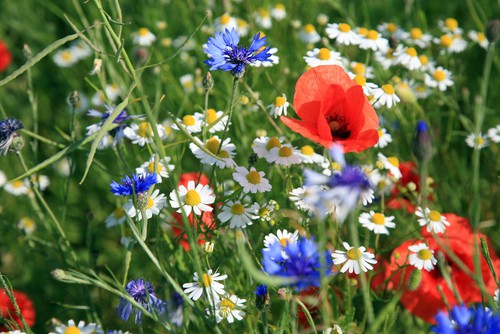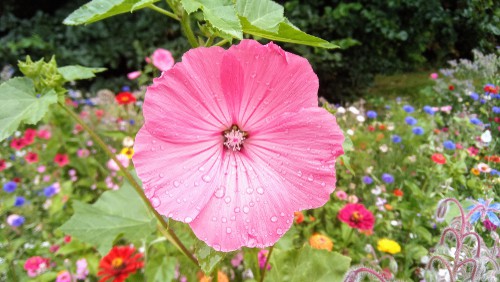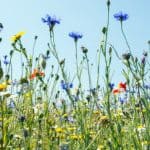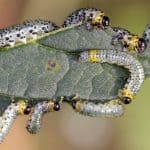Last updated on April 3rd, 2022
Our site is reader supported, this means we may earn a small commission from Amazon and other affiliates when you buy through links on our site.
Wildflower meadows are quickly becoming a wonderful alternative to a border in gardens or lawns because they offer of stunning display for months on end and are very easy to maintain. There are many options for the flowers you can cultivate and the best part is that wildflower meadows tend to naturally fill an existing space and offer food and shelter for wildlife including bees, butterflies and other flying insects that so desperately need extra sources of food.

Choosing Perennials or Annuals
You can select annual flowers that give you a one-time show every year or perennial flowers that come back year after year.
Perennial meadows
Perennial meadows tend to do best in poorer soils because the grass competes less with the wildflowers you plant. So, if you want a perennial meadow and you already have the right soil, you are in luck. If, however, you want a wildflower meadow but you have very rich soil, you can rectify this by removing the top layer and adding some subsoil directly into the mix.
Annual meadows
Annual meadows need very rich soil so, if you have rich soil it might be easier to simply grow an annual meadow and resow your wildflower seeds once a year. Annual meadows also make a wonderful choice if you have an existing border garden that you are trying to convert, one with decently rich soil from the result of previously grown flowers.
Choosing Wildflowers
You can typically get packets of wildflower seeds that offer a mixture of grasses and wildflowers for the exact type of soil and location you have. Wherever possible, get seeds that are of British origin so that you can bring back the flowers that naturally grow in your area. Also, make sure that the seed packets you choose work with your local conditions. You don’t want to take plants that come from the countryside if you don’t live in the countryside and force them to grow in your area because this can be destructive to the native species in your area.
When to sow a wildflower meadow
The best time to sow your seeds in March/April, or in September, contingent upon the conditions of your soil. If you have lighter soil, you will be able to plant the seeds in September and they should germinate and establish themselves quite quickly, producing flowers the following spring.
If you have heavier soil, you will want to wait until March or April to plant your seeds because heavy soil won’t allow the plants to establish themselves before the cold winter months, and this can lead to water-logging and damaging the roots before they’ve had a chance to get going. Ideally, it’s just easier to sow the seeds in spring.
Where to sow seeds
These wildflower seed mixes should be planted in a larger area of your garden if possible, where they will be allowed to thrive without fighting for nutrients.

Preparing the area for sowing seed
Once you have the area in question ready, and the seed packet or box, you should prepare the ground where you plan to grow your wildflowers by removing any weeds by hand and adding a weed-suppressing layer to the ground, such as a sheet of black plastic. This should be done three months prior to sowing the seeds so that you can ensure all of the weeds are done away with.
If you are planting on a large area that suffers from perennial weeds, you might want to use chemical control methods in addition to non-chemical methods.
See our recommended weedkillers in this review
Once the area is ready, dig the soil and loosen it, then rake it in preparation for the seeds. You don’t want to add manure or fertiliser at this stage because it can encourage the grass to grow too much, at the expense of the wildflowers.
When you are ready to sow your seeds, you can cover a large area by hand quite easily. Pure wildflower seeds should be grown at 1 gram per square metre, and wildflower and grass mixes should be grown at 5 grams per square metre. Pay attention to the individual mix you have and the instructions that are provided. Do your best to evenly scatter the seeds, rake them in lightly, and water them thoroughly. Once this is done you only need to protect your seeds with netting whilst they are germinating if you have a problem with birds. Other than that, you needn’t do anything but allow the flowers and grasses to grow naturally.
Learn more about preparing the ground for wildflowers in this article.
Potential Problems
If you have a mixture of grasses and wildflowers, one potential problem you might experience is that the grass is growing too strongly and stealing all the nutrients from the flowers. If this is a problem for you, you can reduce the vigour of your grasses by introducing some semi-parasitic plants like lousewort, rattle, or eye brights. These will help to cut down the grasses and allow the wildflowers access to nutrients.
Popular wildflower seeds to buy
- Attracts Bees and other wildlife to your garden
- Easy to grow
- Seeds and granular compost
- A carefully blended mixture of traditional cottage garden favourites, created to provide a beautiful display of colour throughout the summer months
- Contains flowers that are great for cutting and wll provide a food source for birds and beneficial insects
- Approximately 10 varieties included, covers up to 20 sq. meter. Brings a display of color throughout the summer months
- The RHS Cottage Garden Seed Mix is the perfect blend of traditional favourites for your summer garden.
- Ideal for first-time gardeners, this seed mix covers up to 20m2 and is easy to grow with just three simple steps - shake, rake and awake. Sow in sunny areas for the best results and enjoy beautiful blooms in no time!
- With easy-to-follow planting instructions, our wildflower seeds are perfect for both novice and experienced gardeners alike. Simply prepare the planting area, scatter the seeds, and watch as your garden comes to life with a vibrant mix of annuals and perennials. Our seeds are also packaged in a resealable bag for easy storage and future use
- ! Species of Flower: Purple Tansy, Californian Poppy, Cornflowers mix, Clover mix, Sainfoin, Poppy red, Corncockle, Blue Lupin, Gypsophilla, Nasturtium, Love in a Mist mix, Linum Blue, Four O' Clock, Safflower, Common evening, Pot Marigold. Sheep's Sorrel, Cosmos bipinnatus mix...
- A variety of colorful and fragrant annual and perennial wildflowers, great sourse for bees, butterfly ... to bring life to our wildlife and nutuer
- Packaged in a resealable bag for easy storage and future use Perfect for adding a sustainable and environmentally-friendly touch to your home or business
- Great for adding color to borders, meadows, and other natural areas Makes a wonderful gift for gardeners and nature lovers of all ages
- An easy to grow mixture providing an abundance of attractive wild flowers to add colour, grace and interest to the garden.
- Contains many annual and perennial varieties So flowers this year and every year after
- They are also valuable for the butterflies, bees, seed eating birds and insects they will attract.
- Contains many annual and perennial varieties So flowers this year and every year after
- Easy To Grow Butterflies Birds Bee Friendly Some plants will flower in the first summer, the rest in spring, summer or autumn the next year.
- Pure Flower Seeds
- Mix of Annual & Perennial species
- Sow at 1-2g per square metre
- Great combination for pollinators
- Gives an ornamental meadow
Image credits – Shutterstock.com
Last update on 2025-04-24 / Affiliate links / Images from Amazon Product Advertising API







